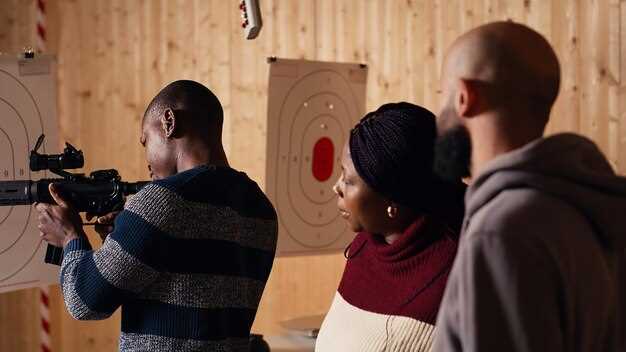Getting Started in Competitive Shooting


Competitive shooting is a challenging yet rewarding discipline that combines precision, focus, and strategy. For beginners, mastering the fundamental shooting skills is crucial in order to excel in this sport. As you embark on your journey, it is essential to understand the key components of effective training that will enhance your performance and build a strong foundation.
Training for competitive shooting involves more than just practicing how to fire a weapon accurately. It requires a comprehensive approach that includes understanding different shooting disciplines, proper equipment selection, and developing mental fortitude. Aspiring shooters must dedicate time to refining their technique while also learning how to handle the pressures of competition.
This guide aims to provide beginners with essential insights into competitive shooting skills, including tips on developing your technique, improving your focus, and creating a structured training plan. By committing to consistent practice and adopting a growth mindset, you will be well on your way to becoming a competitive shooter.
Fundamentals of Stance and Grip for Optimal Performance
In competitive shooting, achieving optimal performance begins with mastering the fundamentals of stance and grip. Your stance provides the foundation for balance, stability, and control during shooting, while an effective grip ensures accuracy and consistency.
To establish a solid stance, position your feet shoulder-width apart, with your weight evenly distributed. Your body should be slightly forward-leaning, with knees slightly bent to enhance mobility and absorb recoil. The angle of your feet and shoulders should align with your target, allowing for better aim and reduced strain on the body. Practicing this stance consistently during training helps build muscle memory, which is critical in a competitive setting.
When it comes to grip, achieving the right hold on your firearm is essential for precision and control. Place your dominant hand high on the grip, ensuring that the webbing between your thumb and index finger is firmly against the beavertail. This positioning minimizes the chances of slippage during shots. Your fingers should wrap around the grip with a firm yet controlled pressure, avoiding excessive tension that could lead to fatigue or jerky movements.
Your support hand plays a crucial role in stabilizing the firearm. Position it alongside the dominant hand, ensuring it grips the frame without obstructing control. Maintain a firm contact point between both hands to create a unified, controlled action when firing.
Regular training focused on both stance and grip will enhance your shooting performance in competitive environments. Incorporate drills that emphasize these elements, allowing you to refine your technique and develop confidence in your abilities. Understanding and practicing these fundamentals not only boosts your precision but also prepares you mentally for the psychological demands of competition.
Drills and Exercises to Enhance Shooting Accuracy
Improving shooting accuracy is crucial for anyone involved in competitive shooting. Regular drills and exercises can significantly enhance your skills. Here are some effective methods to achieve better precision and control.
Fundamental Drills
- Dry Fire Practice: This exercise involves practicing your shooting stance, grip, and trigger control without live ammunition. Focus on perfecting your form and minimizing movement when pulling the trigger.
- Dot Drill: Place small dots on a target at various distances. Aim for each dot, ensuring your shots are grouped closely together. This drill helps with visual tracking and aiming precision.
- Ball and Dummy: In this drill, alternate between live rounds and dummy rounds. This exercise helps you develop muscle memory and reduces anticipation of recoil.
Target Engagement Exercises

- Progressive Distance Shooting: Start shooting at a close range and gradually increase the distance. This helps you adapt to different shooting scenarios and improves accuracy under various conditions.
- Transitional Shooting: Set up multiple targets at different angles and distances. Move between targets while maintaining accuracy, focusing on quick target acquisition.
- Timed Shooting: Use a timer to challenge yourself to complete a series of shots within a specific timeframe. This promotes speed and precision, important for competitive settings.
Advanced Techniques
- Follow-Through Drills: Practice completing the shooting process even after the trigger pull. Focus on your sights and breathing to maintain accuracy and composure.
- Movement Drills: Combine shooting with movement exercises. Practice shooting while moving to gain proficiency in dynamic situations typical in competitions.
- Positional Shooting: Train in various positions (standing, kneeling, prone) to enhance adaptability. Mastering these positions can greatly improve your accuracy in competitive environments.
Implementing these drills into your routine will refine your shooting accuracy and overall competitive performance. Consistency and dedication are key to achieving exceptional results in competitive shooting.
Understanding Competition Rules and Scoring Systems

In competitive shooting, familiarity with the specific rules and scoring systems is essential for success. Each shooting discipline has its own set of regulations that govern everything from equipment restrictions to firing procedures. Understanding these rules not only helps in preparation but also ensures fair competition among shooters.
Types of Competitions
Competitive shooting can encompass various formats, such as precision rifle, practical pistol, and shotgun sports, each with unique guidelines. For instance, in precision shooting, athletes are often scored based on their accuracy and precision in hitting the target, while practical shooting emphasizes speed and efficiency in navigating courses.
Scoring Systems
The scoring system is crucial in determining a competitor’s performance. The methods can vary significantly across disciplines. Some competitions use a point system where shooters earn points for hitting different parts of a target, with more points awarded for hitting smaller or more challenging targets. In contrast, other formats may rank shooters based on time taken to complete a course while considering penalties for misses or procedural errors.
Target Zones
Many competitive shooting events utilize targets with designated scoring zones. Generally, the closer a shot is to the center, the higher the score. Understanding target anatomy and scoring methods is vital, as strategies may differ based on how points are awarded. Shooters should familiarize themselves with the specific scoring zones for their discipline.
Penalties and Rules of Conduct
Competitions often include rules to maintain safety and sportsmanship. Violating these rules can result in penalties, which may include point deductions or disqualification. Common violations include unsafe handling of firearms, failure to follow course rules, or disruptive behavior. Therefore, it’s crucial for competitors to be aware of and adhere to all regulations.
In summary, mastering the competitive shooting environment requires a thorough understanding of the rules and scoring systems. By committing to this knowledge, beginners can significantly enhance their performance and enjoyment in the sport. Preparation is paramount; take the time to study and understand the specific requirements of the competition you wish to participate in.




